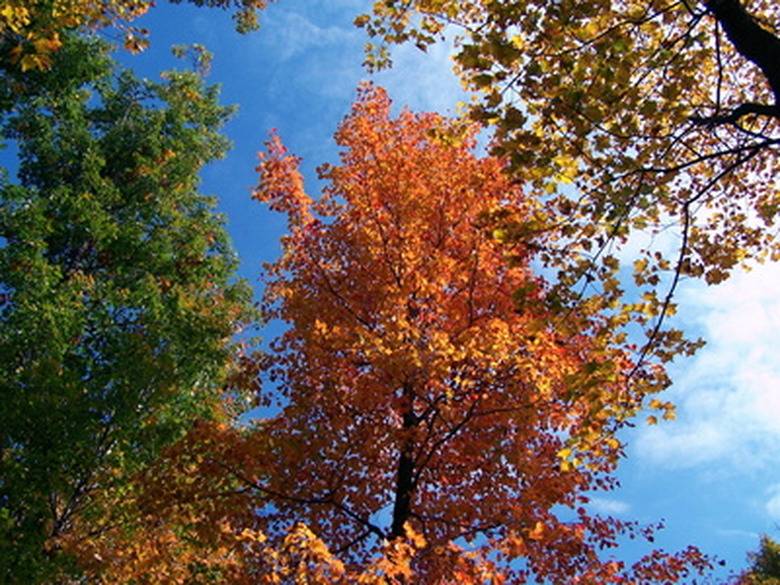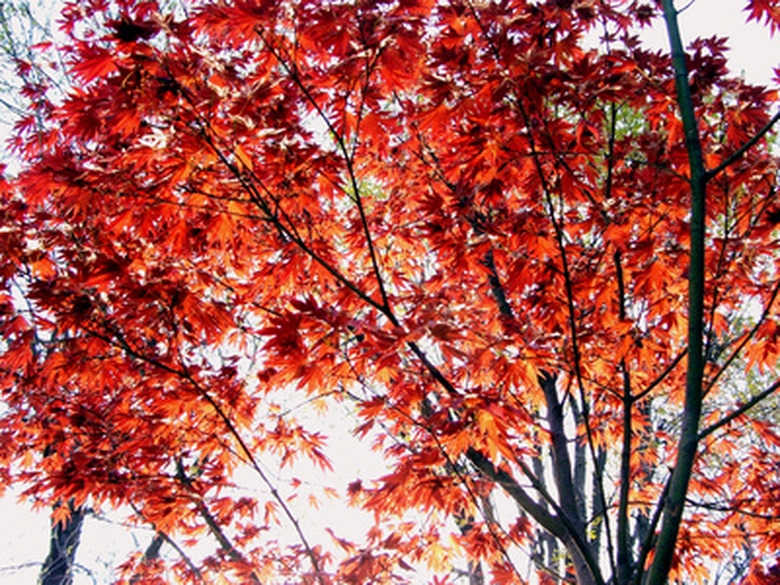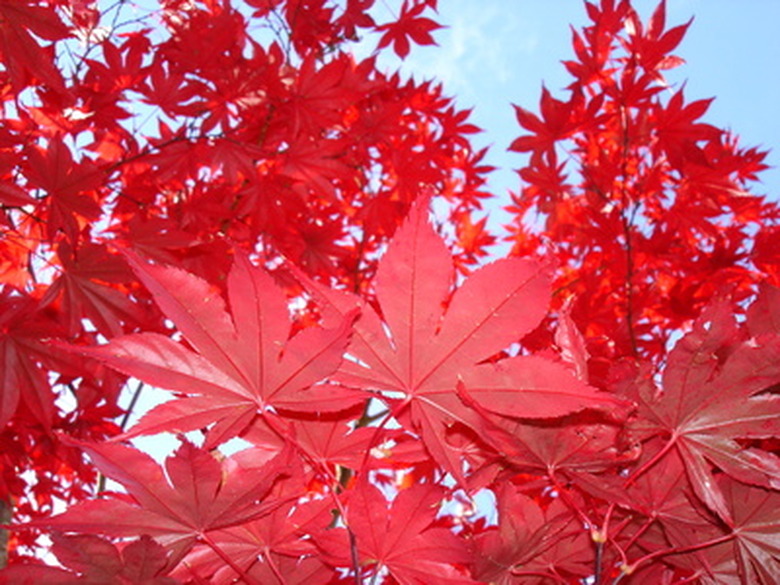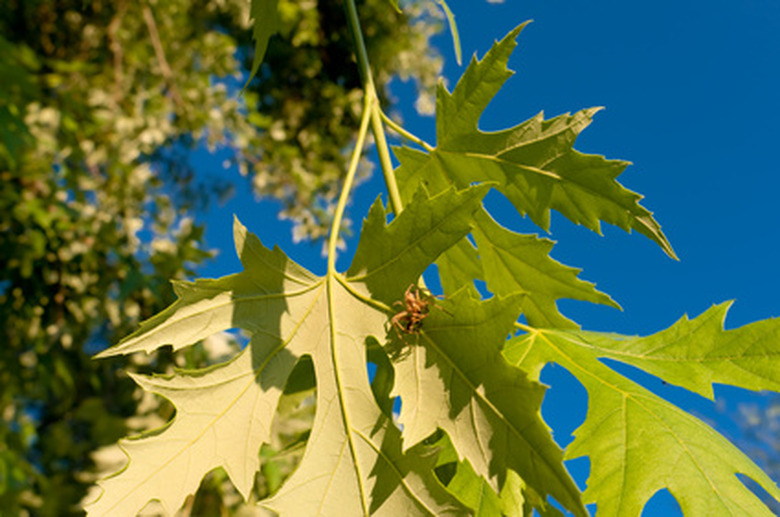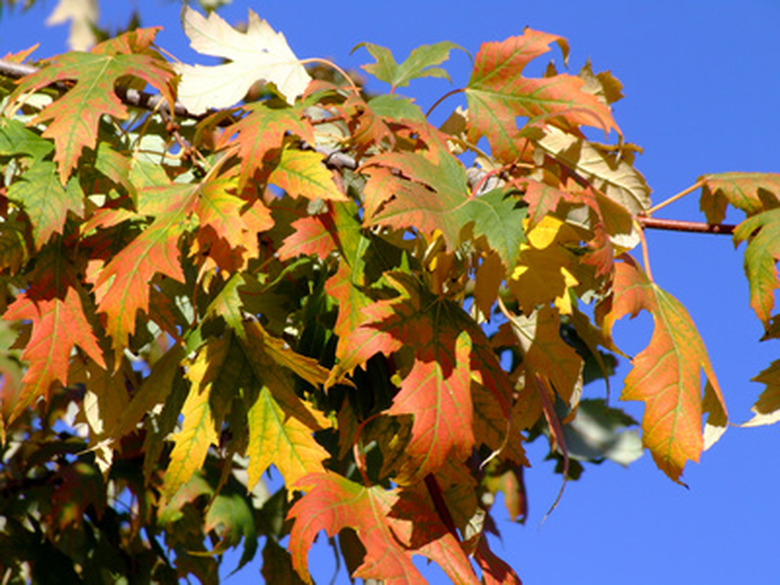How To Identify Maple Trees And Liquid Amber Trees
Maple (Acer spp.) and liquid amber trees (Liquidambar styraciflua) are similar-looking trees that grow in similar climates. Both maples and liquid amber trees, also known as American sweetgum trees, are prized for their sap. Maples and sweet gum trees grow best in USDA hardiness zones 5 through 8 or 9, enduring minimum winter temperatures down to minus-15 degrees Fahrenheit. Some maples can also grow in Zones 3 and 4, however, where winter temperatures get as cold as minus-35 degrees.
Step 1
Look for a 40- to 60-foot tall tree with a 40-foot spread that has green stems turning red in the fall and winter to spot the red maple (Acer rubrum). The red maple tree's leaves turn deep red or yellow in fall, are oppositely arranged on the stems and are 2 to 6 inches long with three to five triangular lobes. The red maple blooms in clusters of tiny red flowers during winter and spring.
- and liquid amber trees (Liquidambar styraciflua) are similar-looking trees that grow in similar climates.
Step 2
Identify the Japanese red maple (A. palmatum atropurpureum) by its small size, growing to only 15 to 25 feet tall and 20 feet wide as a small tree or multiple-stemmed shrub. The Japanese red maple has deeply lobed, red to reddish-purple leaves that are most vibrant in the spring and fall. The leaves are oppositely arranged on the stems and about 4 inches long with five to nine symmetrical lobes that fan out from a single central point.
Step 3
Spot the silver maple (A. saccharinum) by its leaves that are green on top and a silvery-whitish color on the undersides. Growing 50 to 80 feet tall, the silver maple has a vase-shaped canopy and tiny yellowish-red flowers in early to mid-March. The leaves are 3 to 6 inches long and wide with five distinctly separated lobes.
Step 4
Identify the sugar maple (A. saccharum) by its dark-green leaves that turn yellow, rusty orange or slightly reddish in the fall and are 3 to 5 inches wide with five distinct lobes. The sugar maple can reach mature heights of 60 to 75 feet with a 40- to 50-foot spread. This maple tree is known for its sap used in making syrups.
- Identify the Japanese red maple (A. palmatum atropurpureum) by its small size, growing to only 15 to 25 feet tall and 20 feet wide as a small tree or multiple-stemmed shrub.
- Spot the silver maple (A. saccharinum) by its leaves that are green on top and a silvery-whitish color on the undersides.
Step 5
Spot the Tatarian maple (A. tataricum) by its low growth habit, reaching only 15 to 20 feet tall and wide. This maple tree has a rounded shape with medium-green leaves that turn yellow, reddish or reddish-brown in the fall. The Tatarian maple is grown either as a multiple-stemmed shrub or a small tree.
Step 6
Look for a small ornamental tree with dark-green leaves and a rounded shape, reaching a mature height of 20 to 30 feet, to identify the trident maple (A. buergerianum). The trident maple's leaves turn yellow, orange or reddish in the fall.
Step 7
Identify the American sweetgum (Liquidambar styraciflua), also known as the liquid amber tree, by looking for its glossy, star-shaped leaves that turn yellow, orange, purple or red in the fall. Growing 60 to 70 feet tall and 45 feet wide, the sweetgum tree has an oval or pyramidal shaped canopy. A liquid amber-colored sap can be extracted from the tree's trunk and branches.
- Spot the Tatarian maple (A. tataricum) by its low growth habit, reaching only 15 to 20 feet tall and wide.
- The trident maple's leaves turn yellow, orange or reddish in the fall.
Tip
You can distinguish between a liquid amber or American sweetgum tree and a maple tree by looking first for the liquid amber's distinctive glossy foliage. You'll also notice that the sweetgum tree's leaves are arranged in an alternating fashion along the twigs, instead of opposite each other in pairs like most maple trees. The liquid amber tree's wood is also streaked alternately with reddish-brown and black.
Warning
Don't confuse the trident maple with the Tatarian maple tree. Both maples are smaller trees with similar leaves, but the Tatarian maple blooms in fragrant yellowish-green flowers in the springtime, with bright-pink or red winged fruits emerging after the blooms.
